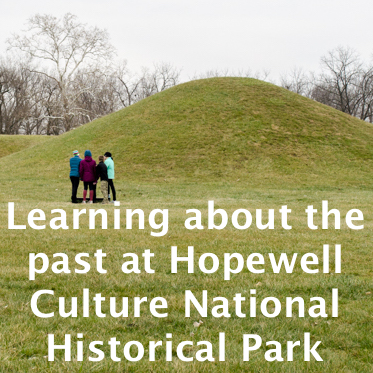After recovering for a day from the rigors of a red-eye, cross-country flight it was time for adventure. When we travel I look for destinations starting with a map of National Park Service units. (Check out this great map and tool of National Park Service sites on nps.gov: https://www.nps.gov/findapark/index.htm) We can always rely on high quality experiences at NPS sites whether they are full-fledged National Parks or Historical Parks or Preserves.
From Cincinnati, we drove north to the Xenia to the Charles Young Buffalo Soldiers National Monument... and it was closed. Dang. Sure, now the NPS site makes it clear when it's open and not, but back in December... no such luck. It's a beautiful house and setting and since we were physically there I'll let the kids submit their Junior Ranger application, but we didn't linger.
No worries. This was a two-Park trip so we continued on to the Hopewell Culture National Historical Park in Chillicothe. (Need pronunciation help with "Chillicothe"? Me, too. We settled on just ensuring we said it differently each time.)
Hopewell protects the mounds and earthworks erected in six sites in the Ohio River Valley. The mounds and embankments were used by the Hopewellian people for special events. Although it looked a lot like the Mima Mounds in Washington those are a natural phenomenon. The Hopewell mounds were intentionally created with a consistency and purpose now mostly lost to us. Look at the different sites and you'll see they have striking similarities for being scattered across the valley.
I've found that starting with a visitor center movie, when there is one, is a great way to get the kids (and me) oriented toward the park. The movie explained why the mounds were built, how they were used, and why they are important to preserve. After the movie, we moved into the museum. Kids have a tendency to to gloss over exhibits unless they're trying to complete their Junior Ranger books. The museum has some great pieces and made the other information real. (Win for accidental learning.)
Outside we walked down to the Mound City group. The wall around the group was about four feet high. The highest mound was over 17 feet high. There are a number of interpretive signs throughout the 13 acre Mound City area. I walked from one to the other. The kids sprinted. Why? Because kids sprint.
From the visitor center the mounds don't look too impressive, but when among the mounds they towered over us. At the far end is a trail that leads down to the Scioto River. It's not the kind of river we're used to so it was good to see. Calm, brown, but apparently threatening. The sign told us to keep kids in control, which of course required they pose completely out of control.
The kids got their badge (and a pile of stickers and patches; small parks rock) and accidentally learned a little about a people that have all but disappeared. The Hopewellian people didn't leave any written records and they simply dispersed into other cultures. Preserving places like Mound City and the other sites protected by the Hopewell Culture National Historical Park is critical to ensuring we don't forget about who has come before us.
